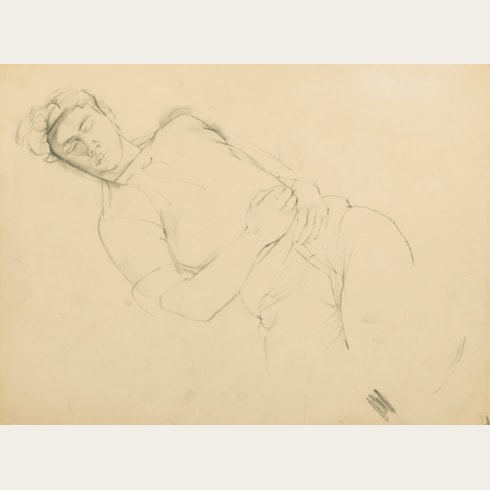John MINTON
(Great Shelford 1917 - London 1957)
The Wheel (Derelict Farm Machine)
Pen and black ink and watercolour, with touches of white heightening, on paper laid down on board.
Signed and dated John Minton 1948 at the upper left.
Inscribed by the artist John Minton / THE WHEEL / Watercolour 1948 on a label pasted onto the verso.
280 x 381 mm. (11 x 15 in.)
Signed and dated John Minton 1948 at the upper left.
Inscribed by the artist John Minton / THE WHEEL / Watercolour 1948 on a label pasted onto the verso.
280 x 381 mm. (11 x 15 in.)
Many of Minton’s drawings and watercolours of the late 1940s depict farms and record farming practices that were soon to be mechanized. This large sheet can be associated with a handful of watercolours by Minton of pieces of farm machinery that were no longer in use, all dating from 1948 and of similar dimensions. A comparable watercolour of Derelict Farm Machinery, signed and dated 1948, was with Stephen Ongpin Fine Art in 2015 and is today in the collection of the Huntington Library, Art Collections, and Botanical Gardens in San Marino, California. Among several other studies of farm machinery by Minton is a watercolour of a Farm Machine, of similar dimensions to the present sheet, which was on the London art market in 20064. A related drawing of Farm Machinery from 1948, also similar in scale, was in the Oliver Brown collection, and another of a Derelict Farm Machine was, like all of these drawings, at one time with the Lefevre Gallery in London.
Related to these watercolours, although earlier in date and without colour, is a pen and wash drawing of Agricultural Implements of 1945, in the Victoria and Albert Museum in London. Also slightly earlier in date is an oil painting of farm machinery in front of a barn of c.1944, probably painted in Cornwall, in a private collection.
Related to these watercolours, although earlier in date and without colour, is a pen and wash drawing of Agricultural Implements of 1945, in the Victoria and Albert Museum in London. Also slightly earlier in date is an oil painting of farm machinery in front of a barn of c.1944, probably painted in Cornwall, in a private collection.
Although he had only a relatively brief career before his death at the age of thirty-nine, John Minton was enormously prolific and achieved a great deal of success in his lifetime. Between 1945 and 1956 he had eight one-man shows, mainly at the Lefevre Gallery in London, as well as taking part in a number of group shows and the Royal Academy Summer exhibitions. Alongside his output as a painter and draughtsman, he provided numerous illustrations for books, book jackets, magazines and advertisements, and also designed posters, wallpaper and stage sets.
While he enjoyed considerable early success, by the 1950’s Minton’s work was becoming overshadowed by that of other artists in his circle, notably Lucian Freud and Francis Bacon. As a friend of his later wrote, ‘He saw himself as overtaken by fashions in art – abstract expressionism among others – for which he had no liking. While others of his contemporaries – Lucien Freud, Francis Bacon, Keith Vaughan - held their ground and came through, Minton saw himself as obsolete, as eccentric and old-fashioned as Edward Lear. He could not come to terms with new developments and he lost faith in his own talent…He was, I suppose, one of those kingfisher-like specimens whose bright plumage briefly glinted then was gone. It might, perhaps, have been different in other circumstances; a little more patience and he could have survived the disorienting shifts in taste.’
Minton devoted much of his later career to teaching, in particular at the Royal College of Art, and was a popular and inspirational figure among his students. As Frances Spalding has written of him, ‘Minton’s virtuoso performances with pencil or pen and ink commended him as a teacher. His students aspired to his dexterity and adopted his devices.’ Minton died, by his own hand, in January 1957.
Provenance
The Lefevre Gallery, London, in 1949
Purchased from them on 18 May 1950 for £21 by a Mrs. Edwards, Gayton, Northamptonshire.
Purchased from them on 18 May 1950 for £21 by a Mrs. Edwards, Gayton, Northamptonshire.
Exhibition
London, The Lefevre Gallery, New Paintings and Water Colours by John Minton, February 1949, no.41 (as The Wheel).












